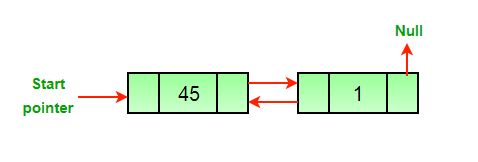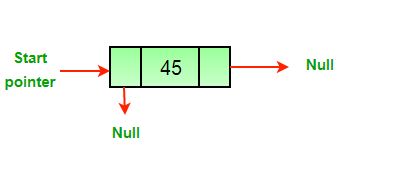Requisito previo: conjunto de listas de enlaces dobles 1 | Introducción e Inserción
Escriba una función para eliminar un Node dado en una lista doblemente enlazada.
Lista original doblemente enlazada

Enfoque: La eliminación de un Node en una lista doblemente enlazada se puede dividir en tres categorías principales:
- Después de la eliminación del Node principal.

- Después de la eliminación del Node medio.

- Después de la eliminación del último Node.

Los tres casos mencionados se pueden manejar en dos pasos si se conocen el puntero del Node a eliminar y el puntero principal.
- Si el Node que se eliminará es el Node principal, haga que el siguiente Node sea principal.
- Si se elimina un Node, conecte el Node siguiente y anterior del Node eliminado.

Algoritmo
- Deje que el Node a eliminar sea del .
- Si el Node que se eliminará es el Node principal, cambie el puntero principal al siguiente encabezado actual.
if headnode == del then
headnode = del.nextNode
- Establezca siguiente de anterior a del , si existe anterior a del .
if del.nextNode != none
del.nextNode.previousNode = del.previousNode
- Establecer prev de next to del , si existe next to del .
if del.previousNode != none
del.previousNode.nextNode = del.next
Java
// Java program to delete a node from
// Doubly Linked List
// Class for Doubly Linked List
public class DLL
{
// Head of list
Node head;
// Doubly Linked list Node
class Node
{
int data;
Node prev;
Node next;
// Constructor to create a new
// node. next and prev is by
// default initialized as null
Node(int d) { data = d; }
}
// Adding a node at the front of
// the list
public void push(int new_data)
{
// 1. Allocate node
// 2. Put in the data
Node new_Node = new Node(new_data);
// 3. Make next of new node as head
// and previous as NULL
new_Node.next = head;
new_Node.prev = null;
// 4. Change prev of head node to
// new node
if (head != null)
head.prev = new_Node;
// 5. Move the head to point to the
// new node
head = new_Node;
}
// This function prints contents of
// linked list starting from the given node
public void printlist(Node node)
{
Node last = null;
while (node != null)
{
System.out.print(node.data + " ");
last = node;
node = node.next;
}
System.out.println();
}
// Function to delete a node in a Doubly
// Linked List. head_ref --> pointer to
// head node pointer. del --> data of node
// to be deleted.
void deleteNode(Node del)
{
// Base case
if (head == null || del == null)
{
return;
}
// If node to be deleted is head node
if (head == del)
{
head = del.next;
}
// Change next only if node to be
// deleted is NOT the last node
if (del.next != null)
{
del.next.prev = del.prev;
}
// Change prev only if node to be
// deleted is NOT the first node
if (del.prev != null)
{
del.prev.next = del.next;
}
// Finally, free the memory occupied
// by del
return;
}
// Driver Code
public static void main(String[] args)
{
// Start with the empty list
DLL dll = new DLL();
// Insert 2. So linked list becomes
// 2->NULL
dll.push(2);
// Insert 4. So linked list becomes
// 4->2->NULL
dll.push(4);
// Insert 8. So linked list becomes
// 8->4->2->NULL
dll.push(8);
// Insert 10. So linked list becomes
// 10->8->4->2->NULL
dll.push(10);
System.out.print("Created DLL is: ");
dll.printlist(dll.head);
// Deleting first node
dll.deleteNode(dll.head);
// List after deleting first node
// 8->4->2
System.out.print(
"List after deleting first node: ");
dll.printlist(dll.head);
// Deleting middle node from 8->4->2
dll.deleteNode(dll.head.next);
System.out.print(
"List after Deleting middle node: ");
dll.printlist(dll.head);
}
}
Producción:
Original Linked list 10 8 4 2 Modified Linked list 8
Análisis de Complejidad:
- Complejidad Temporal: O(1).
Dado que no se requiere atravesar la lista enlazada, la complejidad del tiempo es constante. - Complejidad espacial: O(1).
Como no se requiere espacio adicional, la complejidad del espacio es constante.
¡Consulte el artículo completo sobre Eliminar un Node en una lista doblemente vinculada para obtener más detalles!
Publicación traducida automáticamente
Artículo escrito por GeeksforGeeks-1 y traducido por Barcelona Geeks. The original can be accessed here. Licence: CCBY-SA